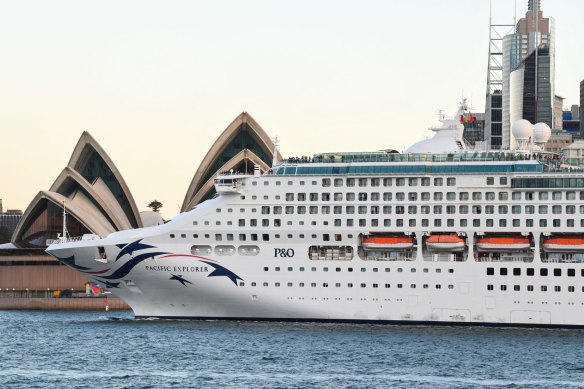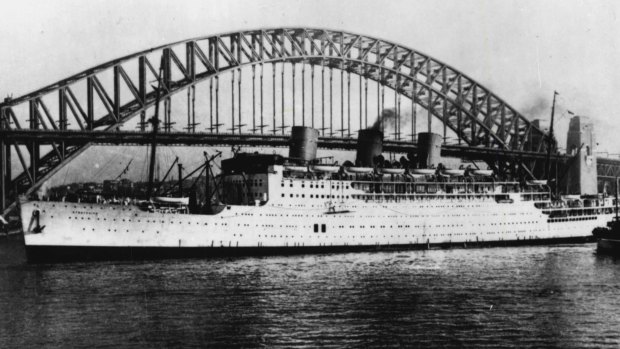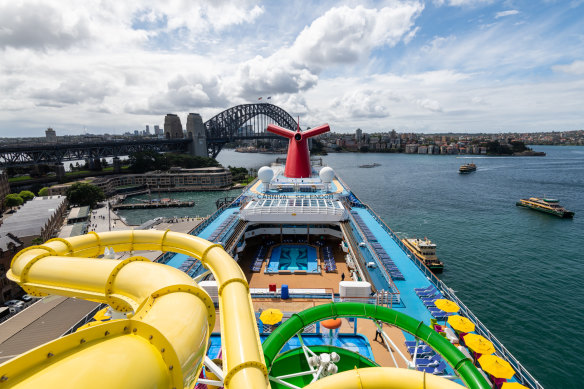Opinion
After 90 years, P&O cruises end in Australia with a whimper
Brian Johnston
Travel writerP&O Cruises Australia isn’t ending in coronavirus, bankruptcy or a sinking. It isn’t going to end with any sort of bang at all, but rather a corporate whimper.
To the surprise and dismay of millions of Australians who’ve sailed on P&O ships, Carnival Corporation announced this week that it will retire the well-known brand in March 2025.

Pacific Explorer in Sydney. The ship was the first to resume cruising from Australian waters after the COVID-era ban was lifted.
P&O ships Pacific Encounter and Pacific Adventure will be renamed Carnival Encounter and Carnival Adventure and absorbed into Carnival Cruise Line. Pacific Explorer will be retired altogether.
The two ships will continue to sail current itineraries, although the company is promising special farewell and sunset cruises over the coming months. Those with bookings on Pacific Explorer after March 2, 2025 will receive a refund or credit for a Carnival cruise.
The announcement has created shockwaves in the travel business.
Carnival Corporation CEO Josh Weinstein has put the move down to the “strategic reality of the South Pacific’s small population and significantly higher operating and regulatory costs”. Cunard and Virgin Voyages also recently pulled out of homeporting in Australia.

The SS Strathaird operated cruises in Australia for P&O in the 1930s.
Yet Carnival Corporation commands almost 60 per cent of the cruise market here, and has 19 ships operating in the region, so the company remains committed to the buoyant local cruise market.
The move is unlikely to change much in the local cruising scene. The disappearance of the venerable P&O brand may have more to do with “operational efficiencies”, in other words, cost savings, than anything else.
Christine Duffy, president of Carnival Cruise Line, says the rebranded Carnival Encounter and Carnival Adventure will provide “much of the same experiences” and itineraries as previously.
Crew, dining choices, entertainment and themed cruises will remain mostly unchanged, while technologies will be upgraded.

Carnival Splendor. Carnival ships have always felt more American than P&O branded ones.
But the question among die-hard P&O fans is whether this will last. It seems unlikely that Carnival-branded ships will continue to belt out Men at Work’s Down Under as they sail into Sydney.
Carnival ships have always offered a different product and atmosphere to those of P&O Cruises Australia, which were aimed firmly at the Aussie market. Carnival ships feel more American, more sedate, and less edgy in their entertainments.
You don’t need a crystal ball to predict that the rebranded ships might increasingly be influenced by Carnival’s corporate stamp. After all, Carnival Corporation is the world’s largest cruise company. Flagship brand Carnival Cruise Line has added eight new ships since 2021, with two more coming in 2027 and 2028.
It seems this is the cruise line of the future, and P&O now one of the past.
The P&O brand originated in Britain in 1837 with the founding of the Peninsular and Oriental Steam Navigation Company, whose ships delivered mail but soon also carried “excursionists” to places such as Spain, Greece and Egypt.
In 1852, P&O won the contract to transport mail to and from Australia. It operated its first Australian cruise in December 1932 when mail steamer Strathaird took 1100 guests on a seven-day itinerary from Sydney to Brisbane and Norfolk Island.
Cabins sold out in a single day, testament to what would become an Australian fondness for cruising. Soon mail steamers were taking passengers to New Zealand, Fiji, Vanuatu and Papua New Guinea.
From the 1950s, when passenger ships faced increasing competition from planes, P&O began operating fully fledged cruise ships such as Himalaya, which sailed from Sydney to South Pacific destinations.
More significantly, between 1945 and 1972 P&O ships such as Canberra and Oriana carried ten-pound Poms and other immigrants from Europe to Australia. The “Australian run” peaked in 1969 with 80,000 passengers.
P&O Cruises’ first ship permanently based in Australia was “fun ship” Fairstar, which operated under the brand between 1988 and 1997, having previously been operated by SITMAR as a migrant ship from the UK, becoming a full-time cruise ship in the ’70s.
In 2000 a company restructure saw its cruising arm split off to create various brands including P&O Cruises Australia, which operated ships such as Pacific Sky, Pacific Star and Pacific Jewel. Pacific Dawn alone carried nearly 1.2 million Australians on cruises between 2007 and 2020.
The P&O name now rests only with P&O Cruises (UK), another Carnival Corporation brand, based in England and dedicated to the UK market.
Sign up for the Traveller newsletter
The latest travel news, tips and inspiration delivered to your inbox. Sign up now.